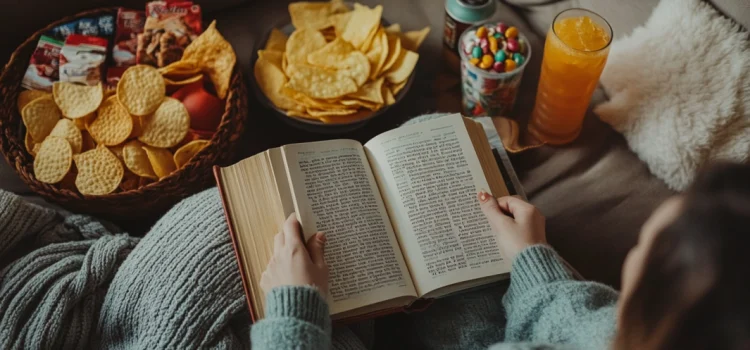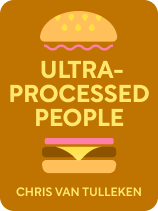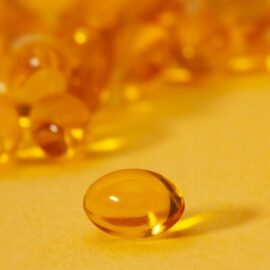

This article is an excerpt from the Shortform book guide to "Ultra-Processed People" by Chris van Tulleken. Shortform has the world's best summaries and analyses of books you should be reading.
Like this article? Sign up for a free trial here.
Why is it so hard to stop eating your favorite chips? What are the implications of supermarkets containing aisle after aisle of sodas, frozen meals, and packaged snacks—and only tiny produce sections?
In Ultra-Processed People, book author, professor, and infectious disease doctor Chris van Tulleken argues that ultra-processed food is destroying our health and our planet. He claims that ultra-processed food isn’t really food at all; rather, it’s akin to an addictive substance that tricks us into eating more.
Below, we’ll explore van Tulleken’s arguments and his recommendations to counteract the effects of ultra-processed food.
Overview of Ultra-Processed People
In the book Ultra-Processed People, Chris van Tulleken argues that ultra-processed food—things like packaged snacks, frozen meals, sodas, and fast food—is destroying our health and our planet. He claims that ultra-processed food (UPF) isn’t really food at all; rather, it’s akin to an addictive substance that tricks us into eating more and more while simultaneously increasing our risk of developing a host of diseases. Plus, the industrial processes used to make UPF harm the environment and contribute significantly to climate change. He argues that the government should increase regulation of UPF and that we should avoid eating UPF as much as we can.
Chris van Tulleken is an assistant professor at University College London and an infectious disease doctor. He has a medical degree from Oxford and a PhD in molecular virology. He’s also a BBC broadcaster; his TV show Operation Ouch, which teaches kids about medicine and the human body, has won two BAFTA awards from the British Academy of Film and Television Arts.
We eat a lot of ultra-processed food, says van Tulleken: UPF now makes up about 60% of the diets of people in the US and UK and a large part of the diets of people all over the world. About 20% of Americans and UK citizens eat a diet consisting of 80% UPF.
Van Tulleken contends that the reason we eat so much UPF and gain weight accordingly isn’t because we lack willpower or we’re not exercising enough—it’s because UPF is designed to encourage overeating. The transnational food corporations that manufacture UPF are governed by the profit motive: They’re publicly traded companies responsible to their shareholders to make as much money as possible, which means selling more products. To do so, they remove expensive natural ingredients from food and replace them with inexpensive chemically altered ingredients.
In this guide, we’ll explore van Tulleken’s answers to the following questions:
- What is ultra-processed food?
- What are the negative health effects of ultra-processed food?
- How does ultra-processed food cause us to overeat?
- Do governments regulate food additives?
- What are the environmental effects of ultra-processed food?
- How can we counteract the negative effects of ultra-processed food?
What Is Ultra-Processed Food?
Most food is processed to some extent. Even baking bread or making a smoothie in the blender are forms of processing. But ultra-processed food is different, says van Tulleken. Ultra-processing doesn’t just modify food; it transforms food into something else entirely.
Van Tulleken argues that UPF isn’t really food: It’s an industrially produced substance that looks, smells, and tastes like food. It starts out as food—usually high-yield crops like corn or soybeans that are grown for animal feed and, as a result, are subsidized in many countries. These inexpensive crops are reduced to their basic molecular constituents, then chemically and physically altered to form synthetic molecules that can mimic all kinds of natural ingredients. These synthetic molecules are then reassembled into something that looks like food and are filled with additives that add flavor, color, saltiness, and sweetness. Without the additives, UPF probably wouldn’t taste like food at all.
Making “food” from industrially created ingredients is not only cheaper than making it from natural ingredients, but it also lengthens the food’s shelf life and makes centralized distribution easier, which further contributes to UPF’s low price. The lower cost of UPF makes it more desirable to consumers; the lower cost of UPF’s synthetic ingredients maximizes profits for food corporations.
Van Tulleken cites Brazilian scientist Carlos Monteiro, who first described the concept of “ultra-processed food” in 2009. Monteiro devised the NOVA system, a now widely used food classification system that divides food into four groups based on the level of processing:
1. Unprocessed or minimally processed food. These are foods in their natural state. Examples include fruits, vegetables, and meat.
2. Processed culinary ingredients. These are ingredients that we use in traditional cooking by combining them with foods in the first category. Examples include butter, sugar, salt, oil, and vinegar.
3. Processed foods. These are foods that are processed mainly for preservation and sold already prepared to eat. Examples include canned food, smoked fish, and fresh bread.
4. Ultra-processed foods. These are foods made primarily from industrially created ingredients, using complex industrial processes such as extracting substances from whole foods and chemically modifying those substances. These foods are intended to be highly profitable, convenient, and desirable. Examples include fast food, frozen meals, most packaged snacks, most store-bought bread, and soda.
If you’re wondering if there’s an easy way to identify UPF, van Tulleken says it’s usually anything that’s wrapped in plastic and contains at least one ingredient that you wouldn’t find in your kitchen. He also suggests that low-fat, no-fat, and other “diet” foods are almost always UPF.
What Are the Negative Health Effects of Ultra-Processed Food?
Van Tulleken says UPF is not only unhealthy, it’s also unsafe, capable of leading to serious illness and even death. In this section, we’ll first explore UPF’s links to a variety of diseases, including obesity. Then, we’ll examine van Tulleken’s contention that lack of willpower and inactivity aren’t responsible for obesity—which leaves UPF as the primary culprit.
UPF Is Linked to a Host of Diseases and Illnesses, Including Obesity
There is a large body of research demonstrating that UPF increases the rates of many forms of disease and illness, including cancer, heart attacks and strokes, type 2 diabetes, weight gain and obesity, mental illness, dementia, and early death. Studies have indicated that it’s the processing of UPF that causes these health problems, rather than simply the nutritional content. Van Tulleken focuses on weight gain and obesity because there are more studies of UPF’s effects on weight.
Widespread obesity didn’t exist for much of human history, writes van Tulleken. Until the beginning of the 20th century, obesity was very rare, especially in children. Since the 1970s, however, obesity has skyrocketed, and it affects more children than ever. Not coincidentally, we also began eating increasing amounts of UPF in the 1950s.
Experts had long thought that the reason obesity wasn’t a problem until recently was historical food scarcity, often resulting from famines and food shortages. However, more and more studies now demonstrate that UPF is probably the primary cause of the global increase in obesity. One study showed that people on a primarily UPF diet consumed an average of 500 calories more per day (and gained weight accordingly) than people on a non-UPF diet, even though both diets contained identical amounts of fat, salt, sugar, and fiber. The people on the non-UPF diet actually lost weight.
Why Lack of Willpower and Inactivity Aren’t Responsible for Obesity
Many people believe that obesity is caused by a lack of willpower or a failure to exercise. According to van Tulleken, these beliefs are unfounded. Rather, obesity is caused by a genetic predisposition combined with an environment that triggers overeating. That environment, says van Tulleken, is the one created by UPF and UPF marketing, both of which are designed to get people to eat as much as possible.
Van Tulleken explains that everyone with obesity has a genetic predisposition to it, but not everyone with a genetic predisposition is obese. The difference is environment: specifically, the environment of UPF and poverty. Poor, urban areas are often characterized by an abundance of fast food restaurants, fast food advertising, and stores selling mostly UPF but very little fresh, minimally processed food. In addition, research shows that all stress, but especially the chronic stress caused by poverty, causes us to secrete a lot more of the hormone cortisol, which increases appetite and causes us to eat more.
People with a genetic predisposition to obesity who are surrounded by UPF and UPF marketing are therefore more likely to eat more UPF, regardless of their willpower.
Van Tulleken also claims that, despite the many studies reaching a contrary finding, obesity is not caused by inactivity. Studies show that people burn the same number of calories per day (about 2,500) whether they live in a rural hunter-gatherer society or an urban, more sedentary one. In other words, we can’t lose weight simply by being more active: Whether we exercise every day or sit at home reading a book, the amount of calories we burn is the same.
This is because when we burn calories through exercise, our body compensates by using less energy on routine bodily functions (for example, our immune, endocrine, or stress systems), so our total energy use stays the same. This allows some of our body’s systems to rest and recuperate. On the other hand, if we sit at a desk all day and are inactive, we use our excess energy on things like being stressed.
Why do so many people believe that exercise results in weight loss and inactivity results in weight gain? Van Tulleken suggests that it’s because the ultra-processed food industry has heavily funded many of the studies that supposedly demonstrate this. For example, Coca-Cola has provided millions in funding to hundreds of research projects finding that inactivity—not sugary sodas—causes obesity. Van Tulleken points out that industry-sponsored studies of sugar-sweetened beverages and weight gain are five times more likely than independent studies to reach conclusions favorable to the industry.
Van Tulleken argues that we’re eating more than we ever have (specifically, more UPF), and that’s what’s causing obesity—not failure to exercise or lack of willpower.
How Does Ultra-Processed Food Cause Us to Overeat?
Van Tulleken explains that we have an internal system governing our food intake, and it’s very good at self-regulating. But UPF throws a wrench in that system, tricking us into eating more—and gaining more weight—even if we’re full or not hungry. In this section, we examine each of these contentions in turn.
Humans Have an Internal System to Automatically Regulate Eating
Human life is fueled by food. Our bodies have adapted over millennia to allow us to effectively consume and use the calories food provides. As a result, we have an internal system capable of automatically regulating what and how much we eat so we can obtain exactly the right amount of energy and nutrients we need to thrive.
This system comprises our stomach, liver, pancreas, small and large intestines, and other organs that transmit signals to and from the brain via various nerves, blood vessels, and hormones, constantly telling our bodies when, what, and how much to eat.
Just as we have a system that governs food intake for purposes of energy and nutrition, we also have a hedonic system, part of which governs eating purely for pleasure. One theory about why we find UPF appealing is that it causes our pleasure system to override our weight regulation system. However, an increasingly likely explanation for why we can’t stop eating UPF is that it short-circuits our weight regulation system completely.
UPF Interferes With Our Internal System by Acting Like an Addictive Substance
Van Tulleken argues that UPF is an addictive substance that deceives our brain and body into eating more of it. In this section, we’ll first examine an experiment van Tulleken conducted on himself that demonstrates how addictive UPF can be. Next, we’ll look at four characteristics of UPF that trick us into overeating: softness, calorie density, added flavorings, and additives.
Van Tulleken’s Experiment on Himself Points to UPF’s Addictiveness
Van Tulleken conducted an experiment on himself to study the effects of UPF. He began by eating no UPF for a month, and then for the next month he ate a diet consisting of 80% UPF.
Van Tulleken describes how his primarily UPF diet made him anxious, exhausted, achy, and less productive. At the end of the four weeks, he’d gained 13 pounds. Tests showed that the hormones in his body that are involved in eating weren’t functioning properly:
- the hormone that signals fullness (leptin) hardly responded to a large meal,
- the hunger hormone (ghrelin) was extremely high just after he ate, and
- the hormone that signals fat storage (also leptin) increased fivefold.
In addition, MRI scans showed increased connectivity between the parts of his brain involved in desire and reward and the parts involved in hormonal control of food intake. The brain pathways didn’t change, but the information flowing through them did—and over time, those brain circuits themselves could change, too.
All of this suggested that van Tulleken’s eating was increasingly governed by subconscious signals telling him to eat more.
Besides van Tulleken’s experiment, there are many other indications that UPF is addictive, including:
- Brain imaging shows that UPF stimulates the brain’s reward system in the same way as addictive drugs.
- People consistently score UPF higher than real food on food addiction scales.
- UPF and addictive drugs are both modified from their natural state to allow for fast, easy delivery of the rewarding substance.
- A high UPF diet causes more deaths worldwide than tobacco.
In addition, says van Tulleken, UPF has many characteristics that trick us into overeating.
UPF’s Softness Tricks Us Into Eating Faster
The chemical, physical, and heat processing UPF undergoes makes it much softer than whole foods. Softer food is easier to eat, so people eat UPF faster than other food. This means they end up eating more: Research shows that eating faster increases the risk of eating more, gaining weight, and having a metabolic disease.
Plus, our digestive system has evolved to break down the physical structure of whole foods—not to handle food so soft that it behaves in our bodies as if it’s already been chewed. The hormones that normally signal you’re full don’t know what to do with UPF. So not only is UPF’s softness causing us to eat more of it, but it’s also tricking us into not feeling full when we do.
UPF’s Calorie Density Tricks Us Into Eating More
Whole foods like vegetables and meat have a high water content, but UPF needs to be dry so it doesn’t go bad. Because it lacks moisture, UPF is very dense in calories. This calorie density, when combined with softness, means that UFC will cause you to consume more calories, faster, than you would with unprocessed foods. Studies consistently show that foods with high calorie density promote eating and weight gain.
UPF’s Added Flavoring Tricks Us Into Thinking We’re Eating Something Nutritious
Van Tulleken says the added flavoring in UPF also tricks us into thinking we’re eating something nutritious, which may cause us to eat more. This happens because we associate certain flavors with nutritious foods, even though ultra-processing destroys the nutrients in whole foods.
When it comes to nutrition, there’s a big difference between whole foods and the components that make up whole foods. Research consistently demonstrates that eating whole foods protects against cancers, heart disease, dementia, and early death. Many studies show that nutrients like vitamins and minerals are only beneficial when consumed in whole foods containing them. When these same nutrients are consumed independently of whole foods, they’re not effective. In other words, multivitamins and supplements generally don’t work for healthy people (people without nutrient deficiencies). They don’t decrease the risk of disease or death.
The process of manufacturing UPF destroys the thousands of molecules that comprise whole foods, removing vitamins, reducing fiber and polyphenols, and generally ridding the food of micronutrients. UPF manufacturers are required by law to add certain vitamins and minerals into their food so we don’t develop deficiencies. However, the few that they add back in don’t make up for all the micronutrients lost in the course of processing. Those lost micronutrients might be precisely the ones that make whole foods so good for you.
In addition to removing micronutrients from food, ultra-processing destroys flavor molecules, so manufacturers also add in flavoring. Van Tulleken explains that added flavorings in UPF affect both smell and taste. We link smells and tastes with our past experiences with food, so these senses can signal to us how nutritious a particular food is likely to be. This means that the added flavoring in UPF may convince our brains that what we’re eating is nutritious, even if it has been stripped of all its micronutrients. In short, added flavoring in UPF may be tricking our systems of smell and taste into thinking we’re eating something nutritious.
For example, van Tulleken notes that Pringles snack chips contain the flavor enhancers glutamate, guanylate, and inosinate—molecules that normally occur in easily digestible proteins such as cooked meats. When we eat Pringles, the added flavoring signals to our brain that we’re eating something akin to a home-cooked stew. Instead, all we get is starch and fats.
Some scientists have theorized that we’re eating more in an attempt to make up for our increasing micronutrient deficiency. This may be why UPF diets can result in malnutrition and obesity simultaneously.
UPF’s Additives Damage Our Microbiome
Plus, additives in UPF may damage our microbiome, leading to overeating and other problems.
Our microbiome consists of all the microorganisms—such as bacteria, viruses, and immune cells—that live in our body, particularly in our gut. Van Tulleken calls the microbiome the body’s largest immune organ; it’s responsible for protecting us from harmful bacteria.
Manufacturers use thousands of additives in UPF, including emulsifiers, stabilizers, leavening agents, artificial sweeteners, and artificial flavors. Our gut microbiome turns some food into beneficial molecules, but food containing additives may harm the microbiome by leading to intestinal inflammation. This can result in overeating.
Even if additives don’t cause overeating, research suggests that they can alter the balance of bacteria in the gut. This imbalance can contribute to a variety of diseases, including rheumatoid arthritis, autoimmune diseases, and even cancer and mental illness.
Don’t Governments Regulate Food Additives?
Most people assume that any chemically altered substances and artificial ingredients in their food have been certified as safe by the government. Unfortunately, van Tulleken explains, that isn’t the case. In the US, for example, the Food and Drug Administration (FDA) allows food companies to “self-certify” their new additives, meaning that they aren’t required to submit any proof to the government that they’ve done testing on UPF’s safety.
How did this happen? In the 1950s, the US government became concerned about the many new industrially produced chemicals that companies were adding to food. The legislature passed a law requiring testing and formal approval by the FDA before an additive could be used in food. However, the law provided an exception for additives that were “generally recognized as safe (GRAS),” so that common ingredients like salt wouldn’t have to go through the FDA’s extensive approval process.
Many UPS manufacturers began using this exception as a loophole, and eventually, due to a backlog in GRAS applications, the FDA decided to allow companies to make their own determinations about whether their additives were safe. This means that UPF manufacturers don’t need to get government approval for new food additives. Not only that, but if a company does apply to the FDA for GRAS approval and the FDA expresses concerns about the safety of the additive, the company can simply withdraw its application and certify the additive’s safety itself.
There are probably around 10,000 food additives in the US, but we don’t even know for sure how many there are because companies that self-certify don’t have to inform the FDA that they’re doing so.
What Are the Environmental Effects of Ultra-Processed Food?
In addition to directly harming human health, UPF also contributes to carbon emissions and environmental destruction on a massive scale.
Rather than growing many small crops for local communities, which is expensive, agribusiness focuses on four or five high-yield commodity crops, such as soy and palm oil. To make these crops profitable, companies either turn them into UPF or feed them to factory animals (and much of that meat is itself made into UPF). Investing heavily in a few commodity crops contributes to climate change in many ways, including:
1. Carbon emissions from the destruction of forests. Tropical forests, which are very good at cleaning carbon dioxide out of the atmosphere and storing it, are clear-cut and burned to grow commodity crops. This releases huge amounts of carbon dioxide into the atmosphere.
In regions like the Amazon, destroying the forest also results in less rain. (Rain in the central Amazon is caused by water evaporating from the ocean and falling on coastal forests; these forests then emit water vapor, which creates clouds that travel inland to create rain.) This lack of rain results in drought. Agribusiness in the central Amazon is not only shooting itself in the foot by altering the weather patterns that irrigate its crops, it’s also contributing to climate change: The southeastern Amazon is now a carbon source rather than a carbon sink.
2. Greenhouse gas emissions from growing, processing, and transportation. Massive amounts of fossil fuels, in the form of everything from fertilizers to gasoline for farm equipment, are required to grow the crops. The machinery required for processing is also energy-intensive. And most UPFs contain ingredients from four or five continents that have to be shipped internationally many times over. These factors further contribute to emissions.
As a result, industrial food production is the leading cause of global biodiversity loss and the second largest contributor to global emissions.
UPF manufacturers also harm the environment through plastic pollution. Coca-Cola, PepsiCo, and Nestlé are the top three plastic polluters in the world. About 90% of all plastic waste ever produced has not been recycled. It’s either burned, disposed of in landfills, or littering our public lands and oceans.
How Can We Counteract the Negative Effects of Ultra-Processed Food?
UPF is harmful and ubiquitous, but we have the power to counteract its negative effects. In this section, we first examine van Tulleken’s contention that governments should regulate UPF—not by banning it, but by taking other measures to limit its consumption. Next, we discuss his suggestion that we eat less UPF or stop eating it altogether.
Government Regulation of UPF
Van Tulleken advocates three primary methods for regulating UPF: prohibiting government policymakers from taking money from the food industry, labeling UPF products accurately, and restricting UPF marketing.
Governments Should Be Prohibited From Taking Money From the Food Industry
The food industry heavily influences government policies. Various “nutritional” foundations exist for the primary purpose of shaping food policy—and they’re funded by an array of UPF companies. Much of the research critical of the link between UPF and health problems is funded by or affiliated with companies that produce UPF.
Yet the data is clear, says van Tulleken, that when an industry funds science, the results are biased in favor of the industry. He argues that the UPF industry should be divorced from scientific research into the effects of UPF, and that government policy shouldn’t be funded—directly or indirectly—by the food industry.
Governments Should Label UPF Products Accurately
Van Tulleken argues that labeling would help the public make informed choices about what they’re buying. He points to Chile, where three-quarters of adults are overweight or obese. There, the government implemented a policy requiring labeling on food products high in calories, sugar, sodium, and saturated fat. The labeling resulted in fewer food purchases.
Governments Should Restrict Marketing of UPF
Marketing is a huge portion of the budget for most UPF. UPF companies often aggressively market their products to low-income communities, sometimes with disastrous results.
For example, in the 1970s, Nestlé targeted poor mothers in developing countries by sending saleswomen dressed as “nurses” into their communities to promote the supposed nutritional benefits of baby formula over breastfeeding. Yet Nestlé knew, or should have known, that many of these communities did not have access to clean water, forcing caregivers to mix the formula or wash the bottles with contaminated water. Nestlé’s practices were linked to thousands of infant deaths.
Van Tulleken argues that to prevent this type of predatory marketing, governments should implement rules for how companies market all UPF.
Choosing Not to Eat UPF
It’s difficult for individual consumers to effect change on a systemic level simply by shopping differently, especially since many people in low-income communities don’t have access to non-UPF foods.
However, if you want to effect change on an individual level and have access to minimally processed foods, van Tulleken suggests experimenting with eating less UPF or cutting it out entirely. He advises going on an 80% UPF diet for a few days, armed with the knowledge you now have about how UPF affects our health. Pay attention to how you feel and whether certain foods feel more addictive to you. (If you think you’re addicted to UPF, get help from a doctor or talk to someone about it.) You may want to adopt a diet where you eat some UPF but avoid whatever makes you feel bad or causes you to overeat. You may want to stop eating UPF altogether.
Exercise: Examine Your Relationship With UPF
Van Tulleken indicates that his primary goal isn’t to tell people what to eat; it’s to make people more aware of and informed about ultra-processed foods and their effects on our bodies. He suggests that you examine these effects by experimenting with UPF and non-UPF diets. Whether or not you do so, it may help to take inventory of the relationship you already have with UPF.
- Which ultra-processed foods feel most addictive to you? List them here. Would you consider eating less of any of these foods, or “quitting” them entirely?
- Are there any ultra-processed foods that cause a negative effect in your body (for example, perhaps they cause you to feel bloated, sluggish, or anxious)? If so, list them along with their effect on you. Would you consider eating less of any of these foods, or “quitting” them entirely?
- What changes could you make to your daily life that would make it easier or more convenient for you to eat fewer ultra-processed foods (for example, cooking extra portions of a healthy dish to freeze for later meals, altering your commute so you can stop at a farmers’ market or a store with ample produce, or carrying healthy snacks so you’re less likely to purchase unhealthy ones)? Describe them here.

———End of Preview———
Like what you just read? Read the rest of the world's best book summary and analysis of Chris van Tulleken's "Ultra-Processed People" at Shortform.
Here's what you'll find in our full Ultra-Processed People summary:
- Why it’s so hard to stop eating your favorite chips
- How the way ultra-processed food is made harms the environment
- Ways to counteract the effects of ultra-processed food






